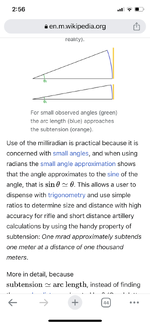WesternSlope
FNG
- Joined
- Mar 1, 2021
- Messages
- 58
Was playing around with JBM ballistics today and noticed on the drop down menu for drop and windage it has mil and mrad as options. I had thought they were the same. To make matters more confusing, one is abbreviated MIL in all caps while the other is abbreviated mil in lower case. When I selected both side by side I found they were close but not the same starting at 325 yards. Interestingly, they also have cm/100m as a drop down option which I would have thought was also the same. When googling this, the closest answer I found was on the Schmidt and Bender website which references that the NATO standard for mrad is 0.98 true mil’s but doesn’t explain why.
they also have cm/100m as a drop down option which I would have thought was also the same. When googling this, the closest answer I found was on the Schmidt and Bender website which references that the NATO standard for mrad is 0.98 true mil’s but doesn’t explain why.
Can anyone explain?
Also which is my swfa 6x? MIL or mil?
Thanks,
Tom
 they also have cm/100m as a drop down option which I would have thought was also the same. When googling this, the closest answer I found was on the Schmidt and Bender website which references that the NATO standard for mrad is 0.98 true mil’s but doesn’t explain why.
they also have cm/100m as a drop down option which I would have thought was also the same. When googling this, the closest answer I found was on the Schmidt and Bender website which references that the NATO standard for mrad is 0.98 true mil’s but doesn’t explain why.Can anyone explain?
Also which is my swfa 6x? MIL or mil?
Thanks,
Tom
Last edited:

